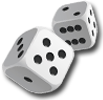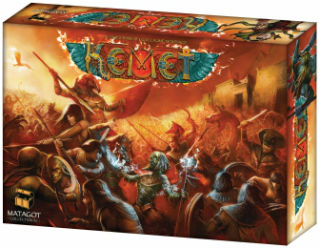



play board games
Board game reviews, strategy tips & session reports
Kemet Board Game Review
 Stats:
Stats:
No. of players: 2-5
Amount of time to play: 90 min
Age requirements: 13+
Set-up time: 5 minutes
Kemet is an Egyptian-themed, area control game with a lot of fighting. You must control certain areas of the board to score but winning battles also scores you VPs.
Kemet Rules Description:
Kemet has two phases night and day. If you end the day phase with 8 VPs you win. You gain VPs by controlling temples, winning battles, owning certain technologies and advancing your pyramids.
You get a player board with nine spaces on it. Each turn you place one of your five action tokens on the board. The bottom row has four spaces, one pray space and three that let you buy a power tile. Prayer points are the main resource in the game and taking a pray actions gets you two prayer points. When you use the buy power tile space you may buy a power tile that matches the color on that space. Power tiles cost prayer points and stay in front of you the rest of the game. They grant you special abilities, let you summon powerful creatures to fight with you troops or get you a VP. Red power tiles help your offense, blue help your defense and white help your economy.
The middle row has three spaces, another pray space, a move space and a space to raise your pyramid. This pray space works the exact same as the one in the bottom row. The move space let you move one group of units (called a troop) one space. You may also spend two prayer points to teleport from one of your pyramids to any obelisk on the board and then move one space. The only restriction on movement is that you cannot move through another player’s city wall without stopping at it first. When you raise a pyramid you pay one prayer points equal to the level you are raising it to. You have a red, blue and white pyramid in your city. These relate to the three different colored power tiles. You can only buy power tiles with a level equal to or less than your pyramid of that color. If you get a level four pyramid it is worth 1 VP.
The top row has another move space and a recruit space. Again the move space is the same as the one in the middle row. The recruit action lets you place units in your city at a cost of one prayer point per unit. You may never have more than five units in one space.
You cannot place an action token on a space that already has one and you must have at least one action token on each level after all five have been placed.
If you move into a space with enemy units you must fight. Each player has the same six combat cards with up to three stats, strength, damage and protection. You discard one of these each battle and play another toward the current battle. You add the strength stat to the number of units you have in the space. Your opponent’s protection value is subtracted from your damage value. The remainder is the number of casualties they suffer. Their remainder is also applied to your troop. If the attacker’s strength is greater than the defender’s and they have units still on the board they win the fight. This gets the attacker a VP. After resolving the battle the defender can retreat or recall all his troops. You gain one prayer point for each unit you recall. Then the attacker has the choice to recall his units for a prayer point each.
Like I said at the top there are two phases night and then day. At night you gain two prayer points, get a divine intervention card and can use any power tiles with night effects. Divine intervention cards grant you bonuses like increasing your stats during battles, giving you prayer points, recruiting units for free and more. Lastly the player with the least VPs determines the turn order.
During the day phase you place action tokens on your player board in turn order. After the day phase is over, you collect prayer points for any temples you control. Controlling two temples gets you a VP. If you control the Sanctuary of the Gods you may sacrifice two units to gain a VP. If any player has 8 VP the game is over.
Quick Review of Kemet:
Kemet is a Euro-style, fighting game of area control. It pays to be aggressive and yet there are a variety of paths that can lead to victory. It is well-balanced and scales well too.
The components for this game are fantastic. Everything is high quality and looks great. The rules are easy to read and follow. The miniatures look great and it all blends well with the theme. Since some VPs can be taken away for controlling a temple or having a level four pyramid he VP tokens are different. Temporary VPs can be lost and are circular while permanent ones are square. I do wish there were more reference cards for the divine intervention cards and power tiles provided. We continuously had to pass the one included around.
I like how balanced this game is and how it rewards aggression and wise retreat. Since you score a VP just by winning a battle you are encouraged to attack. And afterward it might not be worth sticking around. In fact it might just make you a prime target for the next player looking to gain an easy VP. The obelisks keep the board balanced as you can get to a player’s city across the board just as easily as the one you are next to.
The power tiles really add some depth and a bit of a learning curve to the game. They can really help you hone your strategy, but the first few games you’ll probably buy a hodgepodge that look cool. But what you buy really makes a difference. The creature power tiles are really cool too. Creatures can add to your troop’s movement and bolster their combat stats. They also just look great on the board.
Kemet is a fun, balanced area control game. It scales well, looks great and has a cool theme. You are encouraged to be aggressive. If your group doesn’t like “fighty” games they might not like this one. That said I think most everyone else will. It is well-designed plays, pretty quickly and has a nice amount of depth.
Score and synopsis: (Click here for an explanation of these review categories.)
Strategy 4 out of 6
Luck 4 out of 6
Player Interaction 6 out of 6
Replay Value 5 out of 6
Complexity 4 out of 6
Fun 5 out of 6
Overall 5 out of 6

Leave a Reply